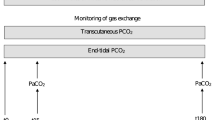Abstract
Purpose
The accuracy of monitors for measuring transcutaneous \( P_{CO_2 } \) (Tc\( P_{CO_2 } \)), end-tidal \( P_{CO_2 } \) (Et\( P_{CO_2 } \)), and nasal Et\( P_{CO_2 } \) was evaluated.
Methods
The measuring devices included a Tc\( P_{CO_2 } \) monitor (TCM3; Radiometer Trading), an Et\( P_{CO_2 } \) monitor (Ultima; Datex-Ohmeda), and a nasal Et\( P_{CO_2 } \) monitor (TG-920P; Nihon Kohden). The sensor electrode of the TCM3 Tc\( P_{CO_2 } \) monitor was applied to the skin of the subject’s upper arm. A sampling tube attached to the proximal end of the tracheal tube was connected to the Ultima Et\( P_{CO_2 } \) monitor. The miniature sensor of the TG-920P nasal Et\( P_{CO_2 } \) monitor was attached to the nostril. The values obtained were compared with direct measurements of arterial \( P_{CO_2 } \)(\( Pa_{CO_2 } \)) obtained by means of an ABL700 blood gas analyzer (Radiometer Trading) in surgically treated patients. The means ± 2 SD of the differences between variables were calculated.
Results
The Tc\( P_{CO_2 } \) monitor (0.19 ± 4.8 mmHg, mean ± 2-SD) was more accurate than the Et\( P_{CO_2 } \) monitor (−4.4 ± 6.5 mmHg, mean ± 2-SD) in patients receiving artificial ventilation via an endotracheal tube and the Tc\( P_{CO_2 } \) monitor was also more accurate than the nasal Et\( P_{CO_2 } \) monitor (−6.3 ± 9.8 mmHg, bias ± 2-SD) in patients breathing spontaneously.
Conclusion
We found that the Tc\( P_{CO_2 } \) monitor was more accurate than the Et\( P_{CO_2 } \) or nasal Et\( P_{CO_2 } \) monitor in surgically treated patients.
Similar content being viewed by others
References
Nishiyama T, Nakamura S, Yamashita K. Effects of the electrode temperature of a new monitor, TCM4, on the measurement of transcutaneous oxygen and carbon dioxide tension. J Anesth. 2006;20:331–334.
Eberhard P, Gisiger PA, Gardaz JP, Spahn DR. Combining transcutaneous blood gas measurement and pulse oximetry. Anesth Analg. 2002;94:S76–S80.
Bendjelid K, Schutz N, Stotz M, Gerard I, Suter PM, Romand JA. Transcutaneous \( P_{CO_2 } \) monitoring in critically ill adults: clinical evaluation of a new sensor. Crit Care Med. 2005;33:2203–2206.
Bland JM, Altman DG. Statistical methods for assessing agreement between two methods of clinical measurement. Lancet. 1986;I:307–310.
Kagawa S, Severinghaus JW. Errors in monitoring transcutaneous \( P_{CO_2 } \) on the ear. Crit Care Med. 2005;33:2414–2415.
Domingo Ch, Canturri E, Lujan M, Moreno A, Espuelas H, Marin A. Transcutaneous measurement of partial pressure of carbon dioxide and oxygen saturation: validation of the SenTec monitor. Arch Bronconeumol. 2006;42:246–251.
Tingay DG, Stewart MJ, Morley CJ. Monitoring of end tidal carbon dioxide and transcutaneous carbon dioxide during neo natal transport. Arch Dis Child Fetal Neonatal Ed. 2005;90:F523–F526.
Morioka J, Yamamori S, Ozaki M. Evaluation of a compact device for capnometry of main-stream type compared with one of side-stream type in a postoperative care unit (in Japanese). Masui (Jpn J Anesthesiol). 2006;55:1496–1501.
Nishiyama T, Hanaoka K. Usefulness of a new nasal cannula with an end-tidal carbon dioxide measuring port (in Japanese). Masui (Jpn J Anesthesiol). 2003;52:424–426.
Herrejon A, Inchaurraga I, Palop J, Ponce S, Peris R, Terradez M, Blanquer R. Usefulness of transcutaneous carbon dioxide pressure monitoring to measure blood gases in adults hospitalized for respiratory disease. Arch Bronconeumol. 2006;42:225–229.
Cuvelier A, Grigoriu B, Molano LC, Muir JF. Limitations of transcutaneous carbon dioxide measurements for assessing long-term mechanical ventilation. Chest. 2005;127:1744–1748.
Janssens JP, Laszlo A, Uldry C, Titelion V, Picaud C, Michel JP. Non-invasive (transcutaneous) monitoring of \( P_{CO_2 } \) (Tc\( P_{CO_2 } \)) in older adults. Gerontology. 2005;51:174–178.
Casati A, Squicciarini G, Malagutti G, Baciarello M, Putzu M, Fanelli A. Transcutaneous monitoring of partial pressure of carbon dioxide in the elderly patient: a prospective, clinical comparison with end-tidal monitoring. J Clin Anesth. 2006;18:436–440.
Dullenkopf A, Bernardo SD, Berger F, Fasnacht M, Gerber AC, Weiss M. Evaluation of a new combined \( Sp_{O_2 } \)/\( Ptc_{CO_2 } \) sensor in anaesthetized paediatric patients. Paediatr Anaesth. 2003;13:777–784.
Aliwalas LL, Nobel L, Nesbitt K, Fallah S, Shah V, Shah PS. Agreement of carbon dioxide levels measured by arterial, transcutaneous and end tidal methods in preterm infants < or =28 weeks gestation. J Perinatol. 2005;25:26–29.
Kagawa S, Otani N, Kamide M, Gisiger PA, Eberhard P, Severinghaus JW. Initial transcutaneous \( P_{CO_2 } \) overshoot with ear probe at 42°C. J Clin Monit. 2004;18:343–345.
Lang CJ, Heckman JG. Apnea testing for the diagnosis of brain death. Acta Neurol Scand. 2005;112:358–369.
Vivien B, Marmion F, Roche S, Devilliers C, Langeron O, Coriat P, Riou B. An evaluation of transcutaneous carbon dioxide partial pressure monitoring during apnea testing in brain-dead patients. Anesthesiology. 2006;104:701–707.
Chhajed PN, Rajasekaran R, Kaegi B, Chhajed TP, Pflimlin E, Leuppi J, Tamm M. Measurement of combined oximetry and cutaneous capnography during flexible bronchoscopy. Eur Respir J. 2006;28:386–390.
Senn O, Clarenbach CF, Kaplan V, Maggiorini M, Bloch KE. Monitoring carbon dioxide tension and arterial oxygen saturation by a single earlobe sensor in patients with critical illness or sleep. Chest. 2005;128:1291–1296.
Author information
Authors and Affiliations
About this article
Cite this article
Hirabayashi, M., Fujiwara, C., Ohtani, N. et al. Transcutaneous \( P_{CO_2 } \) monitors are more accurate than end-tidal \( P_{CO_2 } \) monitors. J Anesth 23, 198–202 (2009). https://doi.org/10.1007/s00540-008-0734-z
Received:
Accepted:
Published:
Issue Date:
DOI: https://doi.org/10.1007/s00540-008-0734-z




